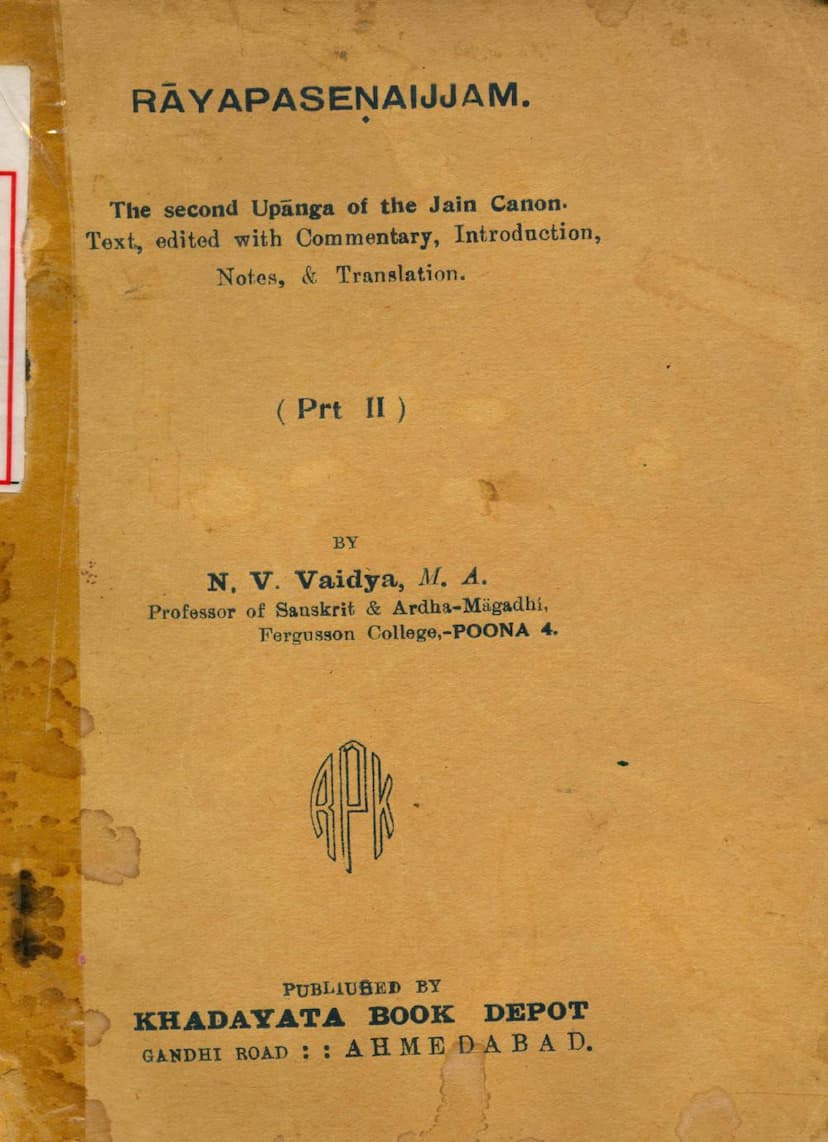Rai Paseniya Suttam Part 02
Added to library: September 2, 2025

Summary
This is a summary of "Rai Paseniya Suttam Part 02," edited by N. V. Vaidya and published by Khadayata Book Depot. The provided text is primarily the preface, introduction, and a substantial portion of the translation of the Suttam.
About the Edition and Author:
- Publisher: Khadayata Book Depot, Ahmedabad.
- Editor/Author: N. V. Vaidya, M.A., Professor of Sanskrit & Ardha-Māgadhi at Fergusson College, Poona.
- Purpose: This is Part II of the edition of the Rāyapaseṇaijjiam (also known as Rājapraśnīyam), the second Upānga of the Jain Canon. Part I was published at the suggestion of the publisher due to the unavailability of other editions. Dr. P. L. Vaidya has already published an excellent edition of Part II.
- Methodology: Vaidya primarily followed the text from the Agamodaya Samiti edition, correcting misprints. The commentary is provided in full, recognizing the terse nature of the text and its utility for students. The translation is intended to be literal, with comprehensive notes. The introduction focuses on points relevant to Part I.
Introduction to the Jain Canon:
- The Siddhānta or Āgama of the Svetāmbara Jains consists of 45 works, categorized into:
- Eleven Angas: (Lists the eleven Angas with their Sanskrit equivalents).
- Twelve Upangas: (Lists the twelve Upangas, noting that the last five are considered sections of Nirayāvalī).
- Ten Prakirņas: (Lists the ten Prakirņas).
- Six Chheda Sūtras: (Lists the six Chheda Sūtras).
- Four Mūla Sūtras: (Lists the four Mūla Sūtras).
- An unnamed group of two works: (Nandisūtra and Anuyogadvāra).
- Canonical Lists and Divisions: The introduction mentions variations in canonical lists, citing J. Charpentier and Dr. Buhler. It also refers to the classification in the Nandisūtra by Devarddhigani Kshamāshramaṇa, which enumerates 78 works in total, though not all are available.
- Historical Context (Svetāmbara/Digambara Split): The text provides a brief historical overview of the Jain community, including the famine in Magadha, the emigration to Karnata led by Sthavira Bhadrabāhu, and the subsequent council at Pāṭaliputra. This council is said to have collected the Jain Canon. The change in practice from nudity to wearing white garments among the remaining community led to the eventual division between the Digambaras ("sky-clad" or naked) and the Svetāmbaras ("white-robed"). The Digambaras did not acknowledge the canon established at Pāṭaliputra.
- Canon Stabilization: The canon later fell into disorder due to scarcity of manuscripts. A council at Vallabhi, under Devardhi Gani Kshamāshramaṇa (around 454 or 467 CE), reordered and fixed the canon. The current classification is based on this council.
Content of the Rāyapaseṇaijjiam:
- Part I: Is described as tedious and dull, with detailed descriptions of buildings, celestial aerial cars, and topography of places like the Sūryābha Vimāna and Jambūdvipa. It also details thirty-two types of dances. The style is generally characterized as "dry as dust, dull, and uninteresting."
- Part II: This is the focus of the translated portion. It is considered full of interest and contains a philosophical discussion between King Paesi and the monk Kesikumāra Śramaṇa. The core of this discussion is the existence or non-existence of the soul apart from the body. The monk ultimately proves the soul's separate and independent existence through illuminating examples and allegories.
Translated Portions (Sūtras 32-45):
The extensive translated sections (from page 10 onwards) appear to describe in great detail the celestial realm, specifically the Sūryābha Vimāna, and the activities within it. This includes:
- Elaborate Descriptions of Palaces and Pavilions: Detailed accounts of their dimensions, construction materials (precious stones, gold, silver, various gems), staircases, altars, gardens, and decorative elements.
- The Sudharmā Assembly Hall: A significant part of the text describes this assembly hall, its doors, accompanying structures like Mukhamandapas (entrance pavilions) and audience halls, gymnasiums, jewelled platforms, sacred pillars (Māṇavaka), Chaitya trees, and Indra banners.
- Worship and Rituals: Descriptions of the worship of Jinas, including idols of the Jinas, their meticulous cleaning, bathing, anointing, and adorning with garments and ornaments. The process includes offerings of flowers, incense, and praises.
- The God Sūryābha: The narrative focuses on the activities of a celestial being named Sūryābha, including his birth, development of faculties, contemplation of duties, and a grand coronation ceremony. This ceremony involves the collection of various sacred materials (waters from different oceans and rivers, earths from sacred places, various grains, flowers, scents, etc.) and a massive celebration with music, dance, and divine performances.
- Daily Activities of Sūryābha: The text describes Sūryābha's personal routines, including his toilet, dressing, and engagement with the "Best Book" (likely a religious scripture).
- Arrangement of Celestial Beings: Detailed seating arrangements within the assemblies for various categories of gods, such as Sāmānika gods (equals in status), chief queens, bodyguards, and others, highlighting their specific roles and attire.
- The Nature of Celestial Existence: The descriptions convey a sense of opulence, grandeur, and perpetual activity in the celestial realm.
Overall:
"Rai Paseniya Suttam Part 02" as presented in this translation, delves into the elaborate descriptions of a celestial abode and the royal life of a divine being. While the preface notes that the first part is dry, this second part, particularly the translated portion, showcases detailed and imaginative descriptions of celestial architecture, rituals, and the grandeur of divine existence, potentially serving as a visual and philosophical account within the Jain tradition. The philosophical discussion on the soul, mentioned as being in Part II, is not explicitly detailed in the provided translated segments, which focus heavily on the celestial descriptions.